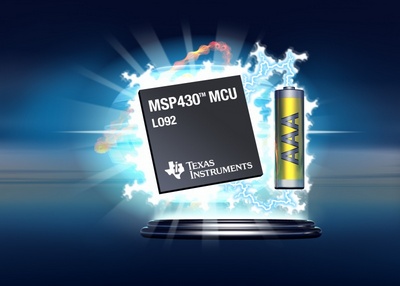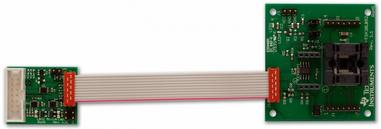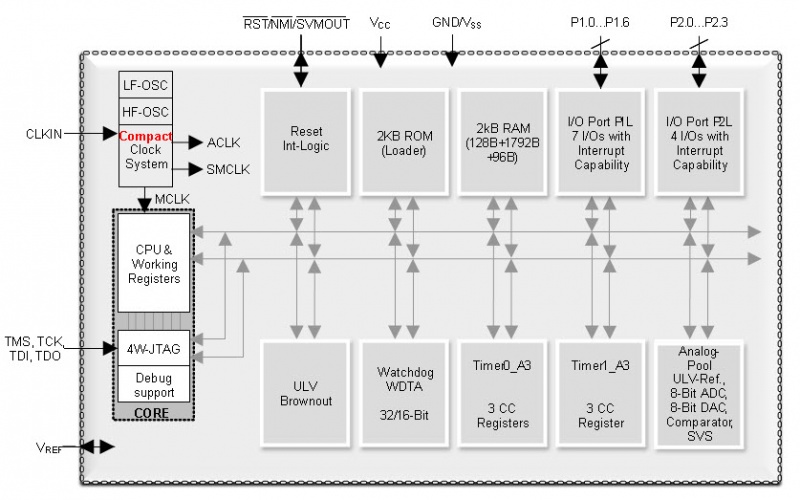Driving smaller, lower cost products that run from a single-cell battery, Texas Instruments announced the industry's first true 0.9-V microcontroller (MCU) as the newest addition to the ultra-low-power MSP430 MCU portfolio. Unlike existing MCUs that claim 0.9-V technology, TI's MSP430L092 MCU inherently operates at 0.9-V, including the entire analog and digital logic. Because it operates at 0.9-V, the MSP430 MCU does not require an on-board boost converter, lowering the entire system's power consumption and reduces the need for external circuitry required by traditional solutions. This allows developers to run applications such as electric toothbrushes, razors, toys and security devices off of a single-cell battery, ranging from AAA to coin cell.

At the core of the L092 is a 16-bit RISC architecture CPU running at 4MHz. The supply voltage range is an incredibly low 0.9V to 1.65V. The active mode power consumption is 45uA/MHz. The memory configuration consists of up to 2kB RAM and 2kB ROM. The same instruction set used on this device can be used across the entire MSP430 platform to assure code compatibility. There is a brownout reset integrated, which consumes zero power and is always on. The new Compact Clock System has a 20kHz low-frequency oscillator, a 1MHz high-frequency oscillator and the ability to source an external clock up to 4MHz. There are several timer peripherals, such as the 32-bit Watchdog timer and two 16-bit general purpose timers. This device is offered in a 14-pin TSSOP package which includes 11 I/Os that are also interrupt capable. The Analog Pool IP has several new features.
Designed from the ground up for ultra low voltage operations, the Analog Pool, or APOOL, is a highly integrated and extremely flexible analog module. The basic blocks of the APOOL are a 256mV voltage reference, a Comparator, and an 8-bit DAC. These blocks combined create an 8-bit ADC, a System Voltage Monitor, or temperature sensing function. Internal voltage dividers can extend this range to 500mV, 1V or 2V input, supporting analog operations across the full range of a typical single cell battery.
Блок-схема микроконтроллера
Key features and benefits of the MSP430L092
- Three 0.9-V MCU variations – MSP430L092 (RAM), MSP430C091 (ROM) and MSP430C092 (ROM) – with up to 2KB RAM and 2KB ROM provide multiple choices for a path to production
- Integrated Analog Functions Pool (A-POOL) can serve as an analog-to-digital converter (ADC), digital-to-analog converter (DAC), system voltage supervisor (SVS), temperature sensor or comparator, eliminating the need for external components to reduce overall bill of materials
- Programmable A-POOL enables the various analog peripheral configurations to run sequentially without user interaction, providing increased flexibility
- Tool kits, including external EEPROM, and ROM-flow process guide help rapidly move from development to final production
- Ultra-low-power consumption of 45 microamps (active) and wake-up time of less than 5 microseconds combined with true 0.9-V operation, enable optimized battery usage
Moving on to development, the MSP430L092 hardware offers a true 0.9V evaluation & testing environment while ensuring seamless debugging with traditional 3V interface.

The MSP430L092 EVM consists of 2 separate PCB boards. The first one, the L092 target board, contains the socket for the device, an EEPROM to store the firmware, two LEDs for debugging purposes, and the breakout pins for prototyping. The second board essentially translates 3V power and JTAG signals from the popular MSP430USB-FET down to 1.5V level for the L092 target board. Connecting these two boards allows for a transparent interface to debug your 0.9V MSP430L092 application from the supported IDEs.
